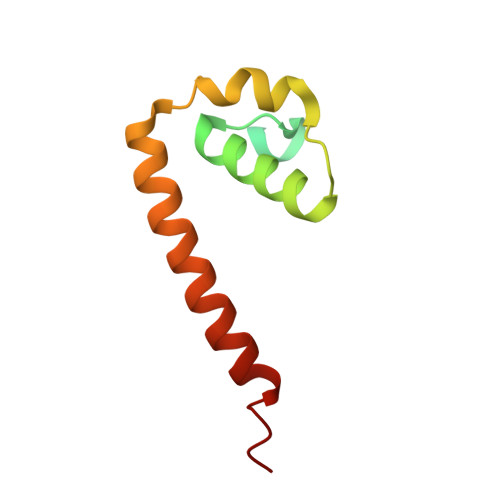Dynamics of Zika Virus Capsid Protein in Solution: The Properties and Exposure of the Hydrophobic Cleft Are Controlled by the alpha-Helix 1 Sequence.
Morando, M.A., Barbosa, G.M., Cruz-Oliveira, C., Da Poian, A.T., Almeida, F.C.L.(2019) Biochemistry 58: 2488-2498
- PubMed: 31034208
- DOI: https://doi.org/10.1021/acs.biochem.9b00194
- Primary Citation of Related Structures:
6C44 - PubMed Abstract:
Zika virus (ZIKV) became an important public health concern because infection was correlated to the development of microcephaly and other neurological disorders. Although the structure of the virion has been determined by cryo-electron microscopy, information about the nucleocapsid is lacking. We used nuclear magnetic resonance to determine the solution structure and dynamics of full length ZIKV capsid protein (ZIKVC). Although most of the protein is structured as described for the capsid proteins of Dengue and West Nile viruses and for truncated ZIKVC (residues 23-98), here we show important differences in the α-helix 1 and N-terminal intrinsically disordered region (IDR). We distinguished two dynamical regions in the ZIKVC IDR, a highly flexible N-terminal end and a transitional disordered region, indicating that it contains ordered segments rather than being completely flexible. The unique size and orientation of α-helix 1 partially occlude the protein hydrophobic cleft. Measurements of the dynamics of α-helix 1, surface exposure, and thermal susceptibility of each backbone amide 1 H in protein structure revealed the occlusion of the hydrophobic cleft by α1/α1' and supported α-helix 1 positional uncertainty. On the basis of the findings described here, we propose that the dynamics of ZIKVC structural elements responds to a structure-driven regulation of interaction of the protein with intracellular hydrophobic interfaces, which would have an impact on the switches that are necessary for nucleocapsid assembly. Subtle differences in the sequence of α-helix 1 have an impact on its size and orientation and on the degree of exposure of the hydrophobic cleft, suggesting that α-helix 1 is a hot spot for evolutionary adaptation of the capsid proteins of flaviviruses.
Organizational Affiliation:
Institute of Medical Biochemistry Leopoldo De Meis, Program of Structural Biology , Federal University of Rio de Janeiro , Rio de Janeiro 21941-902 , Brazil.














